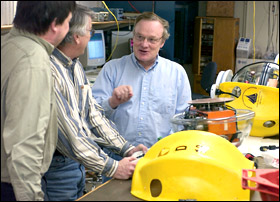
|
 |
Research > Research
Departments > Geology & Geophysics
Geology & Geophysics
Overview | Awards
& Recognition | Photos
 |
 |
| Bob Detrick,
Geology and Geophysics Department chair (right) with research
specialists John Collins (left) and Beecher Wooding and
the ocean-bottom seismometers they are building as part
of a National Science Foundation-funded instrument pool.
These instruments detect and record earthquakes and human-made
sound sources to learn about the planet’s internal structure.
(Photo by Tom Kleindinst) |
The scientists and research staff of the Geology and Geophysics
Department (G&G) study volcanism, the structure and evolution
of the ocean basins and their margins, earthquakes and hydrothermal
processes on the seafloor, and the role of the oceans in past
climate change.
Staff, students, and postdoctoral investigators in G&G totaled
127 in 2003, and were involved in more than 250 research projects.
In July, Associate Scientist Delia Oppo co-led a team of scientists,
technicians, and students from the United States and Indonesia
as they collected seafloor cores in the Makassar Strait, Indonesia.
Oppo and her research team are using these cores to determine
whether long-term variations in the behavior of El Niño/Southern
Oscillation influence regional climate variations on time scales
of hundreds to thousands of years. They want to find out if
changes in ocean circulation and temperature in the western
Pacific happened at the same time as North Atlantic climate
variations during glacial and interglacial periods.
In the spring, Associate Scientist Rob Reves-Sohn led the first
of four expeditions to study a massive sulfide deposit on the
Mid-Atlantic Ridge at the Trans-Atlantic Geotraverse (TAG) site,
about 2,000 miles east of Miami. To understand what is driving
hydrothermal activity at the site, they deployed a network of
seismometers and temperature probes from R/V Atlantis
to monitor earthquake activity associated with faulting and
fluid flow. Statistical correlations between seismic activity
and vent fluid temperatures will be used to study fluid circulation
patterns beneath the surface and to understand the role of faulting
in sustaining hydrothermal flow over tens of thousands of years.
Rob and Juan Pablo Canales, a research associate, returned in
the fall for the second research leg to carry out a seismic
refraction experiment aimed at delineating the position and
size of magma bodies that might be driving hydrothermal activity
at this site. Two additional legs are planned for 2004 to recover
the seismometers and probes.
In September, Joan Bernhard accepted a tenured associate scientist
position in G&G. Bernhard’s research lies at the intersection
of geology, biology, and chemistry—an emerging interdisciplinary
field known as geomicrobiology—as she pursues studies
of tiny single-cell creatures that are surprisingly abundant
in oxygen-depleted environments, such as deep in the Black Sea
and in some seafloor mud sediments.
—Robert S. Detrick (rdetrick@whoi.edu)
Department Chair
|
|
